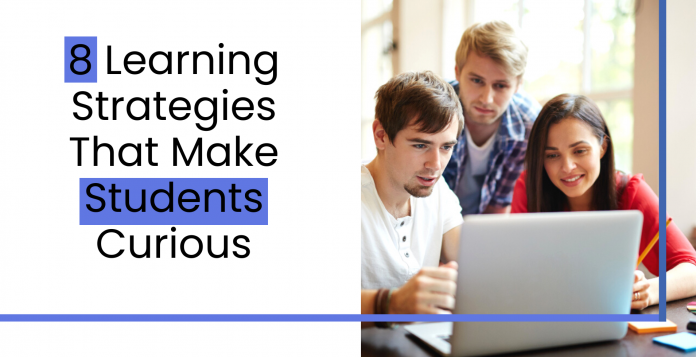8 Learning Strategies That Make Students Curious
In modern times, the popular norm prevailing from elementary schools to high schools in regards to students’ curiosity in learning is that teachers are often suggested to create engaging content for their students. However, little do they know that it is one of the least effective measures to generate curiosity among students towards education and learning.
This newly attained curiosity may get students to be interested in learning more, but such curiosity doesn’t necessarily guarantee students’ engagement with the teachers. Engagement is something far more important than attention. For instance, it doesn’t demand an enriched thinker to forge new ideas with open-mindedness and ask questions.
Where does curiosity come from?
Curiosity is crucial to learning and there are several stages of curiosity that are applied in the world of teaching. These stages shape the learner’s mind through an inside-out approach. To create curiosity towards learning among students, a teacher doesn’t need to apply gimmicks, dress up as their favourite characters, or create amusing content.
Curiosity is something that stems from past experiences and contemporary knowledge. These experiences and knowledge leap out and seek out inherent patterns as our subconscious recognises and finds something useful – the dopamine levels shoot up and later on, help develop sheer interest and curiosity among students towards education and learning.
But the question that might be arising in your mind is, how can one create curiosity in someone? This is the challenge not only teachers but every parent faces. Any enhancement in the learning content should be kept at an absolute minimum, every teacher must be aware of what tends to stimulate interest and curiosity among students and what doesn’t. In this article, we will share with you the 8 crucial learning strategies that can make students curious about their studies in no time.
8 Strategies to Promote Curiosity in Learning
1. Model curiosity in its many forms
Curiosity is an instinct just like any other human-instinct – it can be stimulated and refined with the help of sheer observation and trial. For instance, one must think out loud while reading a comic book, or a simple textbook, while watching a video and having any conservation. Once you pause and think out loud, you can understand things well. Be curious about all that you are thinking, your inquiries, things that stimulate your mind– and most importantly, the courage to follow even a little hint. Curiosity can take you to places you never thought you could.
2. Embed curiosity at the core of the instructional design process
It is an example of inquiry-based learning and with this type of learning students don’t need to worry about learning any facts or doing any activities. Put briefly, it is a face-to-face session in which the teacher asks their students questions. It can be synonymised with a QFT session.
3. Analyse curiosity
Help students see their parts or understand its causes and effects.
When teaching students with the two above-mentioned options, the teacher must help the students observe the stimulation of their curiosity, and make them understand the causes and effects. The positive consequences of this are that numerous students will understand their interests and work towards achieving them. It will be quite easy for the teacher to educate the students with a certain type of stimulating mindset.
4. Reward curiosity
If you want a plant to grow, you feed it – Curiosity is the same.
Teach the students by informing them about the benefits of thinking positively and at the same time, the power of visualising their interests. This can be attained by making the students identify and visualise the outcomes and results of their hard work towards their own interests. This will further lead to enhancement in their curiosity and incremental learning power.
5. Make curiosity personal
Once you have undertaken all the steps mentioned above, it is now mandatory to shed light upon the enhancement of students’ decision-making skills that would further increase their curiosity. For instance, when taking a test of an essay, let the students choose the essays for themselves.
This will develop their interest and students, in the end, will produce astonishing results, even the incompetent students as well. Put briefly, you can start asking the students what kind of essays they would like to write, it can be anything from climate change to the prospects of the prevailing contagion.
6. Let students lead
It’s difficult to be curious if the learning is passive and the student doesn’t have any control. Curiosity is difficult to attain if the learning styles of the students are passive and mundane. Hence, it is mandatory for the teachers to allow students, especially the high school students to use the self-directed learning model – which was explained in the previously mentioned steps and create their project learning units. This will help enhance their decision-making skills and also inspire pure curiosity.
7. Spin content
Frame content like a marketer–as new, controversial, ‘frowned upon,’
In this step, you need to break some popular norms and stereotypes that prevail around the schools – for instance, break a rule of teaching a banned book. This will increase the curiosity of students, further leading to their dopamine increase. Put briefly, they are doing something ‘illegal’ and exciting.
Be careful with this one, if the school is strict and teaching a banned book would make you suffer severe consequences than you must avoid doing so at all costs. Instead, you must undertake something else just like this. Some students may need to take help from reliable law assignment writing services and may ask other students for references.
8. Focus on questions, not answers
Every day you must find some time to answer the questions of your students. Since asking the question is an excellent way of increasing curiosity, it is mandatory for teachers to undergo this unit-entry lesson every day. Make sure the answers to the questions asked must be of quality, quantity, and refining. Do not sabotage any of the attributions.
Follow the tips shared in this article to inspire curiosity.



